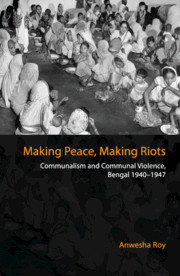Book contents
- Frontmatter
- Frontmatter
- Contents
- Maps and Figures
- Acknowledgements
- Abbreviations
- Glossary
- Introduction
- 1 The Dacca Riot, 1941
- 2 Famine 1943 – Towards a Hardening of Community Identities
- 3 From Community to Communal: The Bengal Secondary Education Bill and the Idea of Pakistan
- 4 The Great Calcutta Killing, August 1946
- 5 Noakhali Riots, October 1946
- 6 A Test of Faith: Gandhi in Noakhali and Calcutta 1946–47
- Concluding Remarks
- Appendix 1
- Appendix 2
- Appendix 3
- Appendix 4
- Bibliography
- Index
6 - A Test of Faith: Gandhi in Noakhali and Calcutta 1946–47
Published online by Cambridge University Press: 23 October 2018
- Frontmatter
- Frontmatter
- Contents
- Maps and Figures
- Acknowledgements
- Abbreviations
- Glossary
- Introduction
- 1 The Dacca Riot, 1941
- 2 Famine 1943 – Towards a Hardening of Community Identities
- 3 From Community to Communal: The Bengal Secondary Education Bill and the Idea of Pakistan
- 4 The Great Calcutta Killing, August 1946
- 5 Noakhali Riots, October 1946
- 6 A Test of Faith: Gandhi in Noakhali and Calcutta 1946–47
- Concluding Remarks
- Appendix 1
- Appendix 2
- Appendix 3
- Appendix 4
- Bibliography
- Index
Summary
In an atmosphere of utmost despair Gandhi came to Noakhali. Even before the Noakhali riots began, he had anticipated them. He wrote in Harijan after the Calcutta riots, ‘We are not yet in the midst of a civil war, but we are nearing it.’ With Noakhali riots, Gandhi suffered from deep self-doubt, not about the principles of nonviolence and truth, but about himself as an adequate embodiment of these two values. He saw the riots as a personal failure.
Even before he actually went to Noakhali, he said in a prayer meeting at Delhi that making peace had been his ‘vocation’ since early youth. He never believed that peace was impossible for the two warring communities. Calling himself an optimist, he said that he saw a ‘ faint ray of hope’ for peace (italics mine). He knew that his visit to Noakhali was inevitable as nothing else had so far worked to bring about normalcy. Hindusthan Standard reported on 19 October that at an after-prayer address he said that what hurt him more than the killings was the abduction of women. Female chastity was a vital matter for him. He received messages from Bengal, asking him to quell the raging fury. He was anxious to go to Bengal, but felt that it was his duty to wait till Nehru returned to New Delhi from Afghanistan and the meeting of the Congress Working Committee discussed developments in Bengal. Meanwhile, he deputed Sudhir Ghose, an eminent Congress leader, to visit East Bengal, especially Noakhali, and bring him first hand reports. On 19 October, he made up his mind to go.
He left for Calcutta on 28 October. However, his visit to Noakhali was delayed because transportation could not be arranged by the Bengal Government for a long time. Suhrawardy also pleaded with Gandhi to delay his departure to Noakhali till conditions were safer there. So, until such arrangements could be made, Gandhi had to stay at Sodepur near Calcutta, where he decided to help the riot-ravaged city. He impressed upon Suhrawardy that the popularly elected League ministry held the primary responsibility for restoring peace and order in Bengal. He also emphasized that there should be no further reliance on the British government.
- Type
- Chapter
- Information
- Making Peace, Making RiotsCommunalism and Communal Violence, Bengal 1940–1947, pp. 214 - 246Publisher: Cambridge University PressPrint publication year: 2018



